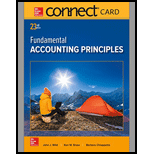
Concept explainers
Concept introduction:
Sources of funds:
A business can raise find through several sources like own capital investment, issuing shares (Common or preferred), issuing debt instruments or taking loans from lenders. Some sources of finance are discussed as follows:
Common Stock and Preferred Stock:
These are two types of the share capital of a company. Common Stock represents the Common shares issued to the shareholders and preferred stock represents the preference shares issued. Preference shares are given preference in payment of dividends and repayment of capital. Common shareholders get the inbuilt right to vote in decisions of the company and preference shareholders generally do not get this right but they may get voting rights with special provisions.
Loan from lenders:
The business may take a loan from banks for a certain period and it has to repay the loan with interest as per the terms of the loan.
Requirement-a:
To prepare: The
Requirement-b:
To discuss: Three proposals of expansion
Requirement-c:
To recommend: The best option of finance
Want to see the full answer?
Check out a sample textbook solution
Chapter 13 Solutions
Connect Access Card for Fundamental Accounting Principles
- Amish Company applies manufacturing overhead to jobs on the basis of machine hours used. Overhead costs are expected to total $276,660 for the year, and machine usage is estimated at 125,300 hours. For the year, $296,534 of overhead costs are incurred and 132,300 hours are used. Compute the manufacturing overhead rate for the year.Need Answerarrow_forwardA company has current assets with a book value of $50 million, which could be sold for $52 million. The company's fixed assets have a book value of $120 million, but they could be sold for $150 million today. The company has total debt with a book value of $80 million, but due to declining interest rates, the market value of the debt has increased to $90 million. What is the ratio of the market value of equity to its book value? (Round to 2 decimal places)arrow_forwardWhat amount should be reported as interest payable?arrow_forward
- need this question answer General accounting questionarrow_forwardGeneral Accounting Questionarrow_forwardWhich of the following statements concerning standards is correct? A. Standards cannot be used for product costing and cash budgeting. B. Standards should not be attainable by the average worker. C. Variances are likely when compared to actual results. D. All of the above. E. None of these.arrow_forward
- What is material quantity variancearrow_forwardAmish Company applies manufacturing overhead to jobs on the basis of machine hours used. Overhead costs are expected to total $276,660 for the year, and machine usage is estimated at 125,300 hours. For the year, $296,534 of overhead costs are incurred and 132,300 hours are used. Compute the manufacturing overhead rate for the year.arrow_forwardAccounting answer?arrow_forward
- Determine the expected profit or lossarrow_forwardThe following data were taken from the accounts of Burnside Bedknobs, a retail business. Determine the gross profit. Sales Sales returns and allowances $ 1,16,900 1,100 Sales discounts 400 Merchandise inventory, January 1 30,000 Purchases during the period 1,00,000 Purchases returns and allowances during the period 2,000 Purchases discounts taken during the period 2,800 Freight-in on merchandise purchased during the period 1,500 Merchandise inventory, December 31 50,000arrow_forwardWhat is Everest Industrial solutions net income for the year on these general accounting question?arrow_forward

 AccountingAccountingISBN:9781337272094Author:WARREN, Carl S., Reeve, James M., Duchac, Jonathan E.Publisher:Cengage Learning,
AccountingAccountingISBN:9781337272094Author:WARREN, Carl S., Reeve, James M., Duchac, Jonathan E.Publisher:Cengage Learning, Accounting Information SystemsAccountingISBN:9781337619202Author:Hall, James A.Publisher:Cengage Learning,
Accounting Information SystemsAccountingISBN:9781337619202Author:Hall, James A.Publisher:Cengage Learning, Horngren's Cost Accounting: A Managerial Emphasis...AccountingISBN:9780134475585Author:Srikant M. Datar, Madhav V. RajanPublisher:PEARSON
Horngren's Cost Accounting: A Managerial Emphasis...AccountingISBN:9780134475585Author:Srikant M. Datar, Madhav V. RajanPublisher:PEARSON Intermediate AccountingAccountingISBN:9781259722660Author:J. David Spiceland, Mark W. Nelson, Wayne M ThomasPublisher:McGraw-Hill Education
Intermediate AccountingAccountingISBN:9781259722660Author:J. David Spiceland, Mark W. Nelson, Wayne M ThomasPublisher:McGraw-Hill Education Financial and Managerial AccountingAccountingISBN:9781259726705Author:John J Wild, Ken W. Shaw, Barbara Chiappetta Fundamental Accounting PrinciplesPublisher:McGraw-Hill Education
Financial and Managerial AccountingAccountingISBN:9781259726705Author:John J Wild, Ken W. Shaw, Barbara Chiappetta Fundamental Accounting PrinciplesPublisher:McGraw-Hill Education





